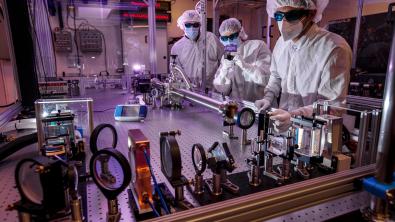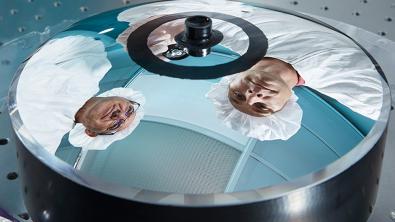The Lawrence Livermore National Laboratory is home to the world’s largest laser system, the National Ignition Facility (NIF). The NIF with its 192 beam lines and over 40,000 optics has been an engine of innovation for lasers and optics technologies for the last couple of decades. The Lasers and Optics intellectual property portfolio is the culmination of the many groundbreaking developments in high energy, high peak power and ultrashort pulse laser system design and operation, including technologies related to Laser Diodes, Fiber & Disk Lasers, Compact Telescopes, High Damage Threshold Gratings, High Power Optical Components and their Fabrication and Coating Techniques. The thrust of the research and development at the NIF has been to realize novel approaches for laser systems, optical components and their applications that are more compact and higher efficiency while reliably delivering ever higher energy and peak power capabilities required in the furtherance of LLNL’s missions in Stockpile Stewardship and High Energy Density Science.
Portfolio News and Multimedia
It’s the late 1990s. Lloyd Hackel and Brent Dane are researchers in Lawrence Livermore National Laboratory’s (LLNL) laser science and technology program.
They’re developing laser technology for X-ray lithography and satellite imaging research for the Department of Defense when the phone rings. On the line is Curtiss-Wright’s Metal Improvement Company (MIC) asking about something Hackel and Dane haven’t worked on before: high-peak-power laser peening for commercial applications in manufacturing.
This is an example of how LLNL’s mission-focused work advancing national security can lead to technology spin-offs with commercial importance through the Innovation and Partnerships Office (IPO).
For more, watch the YouTube video.
Decades of cutting-edge laser, optics and plasma physics research at Lawrence Livermore National Laboratory (LLNL) played a key role in the underlying science that the semiconductor industry uses to manufacture advanced microprocessors. Now a new research partnership led by LLNL aims to lay the groundwork for the next evolution of extreme ultraviolet (EUV) lithography, centered around a Lab-developed driver system dubbed the Big Aperture Thulium (BAT) laser.
LLNL plasma physicists, Brendan Reagan and Jackson Williams, are the project’s co-lead principal investigators. The project includes scientists from SLAC National Accelerator Laboratory; ASML San Diego; and the Advanced Research Center for Nanolithography (ARCNL), a public-private research center based in the Netherlands.
Starris: Optimax Space Systems and Lawrence Livermore National Laboratory (LLNL) have entered a commercialization partnership for LLNL’s patented monolithic telescope technology, which accelerates rapid deployment of modular optical designs for high-resolution or high-sensitivity space imagery.
Starris has collaborated over the last decade with LLNL’s Space Program to develop the monolithic telescope technology and will manufacture — at scale and with customization options — the precision-fabricated optical lens that forms the image in the telescope. The collaboration with LLNL is now extended via a government-use license for commercializing the technology through LLNL’s Innovation and Partnerships Office (IPO).








